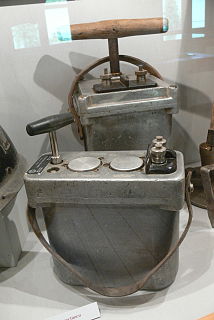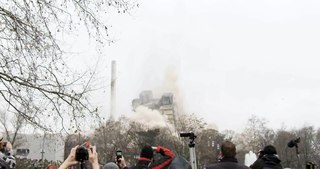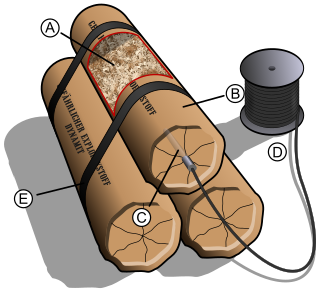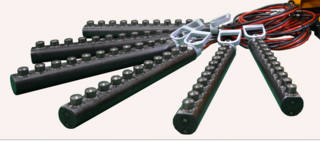 W
WDemolition, or razing, is the science and engineering in safely and efficiently tearing down of buildings and other artificial structures. Demolition contrasts with deconstruction, which involves taking a building apart while carefully preserving valuable elements for reuse purposes.
 W
WThe Achaemenid destruction of Athens was accomplished by the Achaemenid Army of Xerxes I during the Second Persian invasion of Greece, and occurred in two phases over a period of two years, in 480-479 BCE.
 W
WAtomic demolition munitions (ADMs), colloquially known as nuclear land mines, are small nuclear explosive devices. ADMs were developed for both military and civilian purposes. As weapons, they were designed to be exploded in the forward battle area, in order to block or channel enemy forces. Non-militarily, they were designed for demolition, mining or earthmoving. However, apart from testing, they have never been used for either purpose.
 W
WBierrum is a British civil engineering and construction company, that has built all of Britain's concrete cooling towers at the country's power stations since 1965.
 W
WA blasting machine or shot exploder is a portable source of electric current to reliably fire a blasting cap to trigger a main explosive charge. It is mostly used in mining and demolition.
 W
WIn the controlled demolition industry, building implosion is the strategic placing of explosive material and timing of its detonation so that a structure collapses on itself in a matter of seconds, minimizing the physical damage to its immediate surroundings. Despite its terminology, building implosion also includes the controlled demolition of other structures, such as bridges, smokestacks, towers, and tunnels.
 W
WA bulldozer is a large and heavy tractor equipped with a substantial metal plate used to push large quantities of soil, sand, snow, rubble, or similar material during construction or conversion work and typically equipped at the rear with a claw-like device to loosen densely compacted materials. Most bulldozer tractors are continuous tracked, also termed a crawler.
 W
WDam removal is the process of demolishing a dam, leaving a river to flow freely. It is undertaken for a variety of reasons that include environmental rehabilitation, structural weakness and maintenance expense.
 W
WIn the context of physical construction, deconstruction is the selective dismantlement of building components, specifically for reuse, repurposing, recycling, and waste management. It differs from demolition where a site is cleared of its building by the most expedient means. Deconstruction has also been defined as “construction in reverse”. Deconstruction requires a substantially higher degree of hands-on labor than does traditional demolition, but as such provides a viable platform for unskilled or unemployed workers to receive job skills training. The process of dismantling structures is an ancient activity that has been revived by the growing field of sustainable, green method of building.
 W
WDemolition waste is waste debris from destruction of buildings, roads, bridges, or other structures. Debris varies in composition, but the major components, by weight, in the US include concrete, wood products, asphalt shingles, brick and clay tile, steel, and drywall. There is the potential to recycle many elements of demolition waste.
 W
WThe destruction of Warsaw was Nazi Germany's substantially-effected razing of the city in late 1944, after the 1944 Warsaw Uprising of the Polish resistance. The uprising infuriated German leaders, who decided to destroy the city as retribution.
 W
WAn explosive device is a device that relies on the exothermic reaction of an explosive material to provide a violent release of energy.
 W
WHouse demolition is a method Israel has used in the Israeli-occupied territories since they came under its control in the Six-day war to achieve various aims. Broadly speaking, the house demolitions can be classified as either administrative, punitive or as a result of military operations. The Israeli Committee Against House Demolitions estimated that Israel had razed 49,532 Palestinian structures as of 2019. Administrative house demolitions are done to enforce building codes and regulations, which in the occupied Palestinian territories are set by the Israeli military. Critics claim that they are used as a means to Judaize parts of the occupied territory, especially East Jerusalem. Punitive house demolitions involves demolishing houses of Palestinians or neighbors and relatives of Palestinians suspected of violent acts against Israelis. These target the homes where the suspects live. Proponents of the method claim that it deters against violence while critics claim that it has not been proven effective and might even trigger more violence. Punitive house demolitions has been criticized by human rights organization as a form of collective punishment and thus a war crime under international law.
 W
WA hydraulic splitter, also known as rock splitter or darda splitter, is a type of portable hydraulic tool. It is used in demolition jobs which involve breaking large blocks of concrete or rocks. Its use in geology was first popularized by volcanologist David Richardson.
 W
WYacoub Mousa Abu Al-Qia'an was a 47-year-old Israeli Bedouin schoolteacher who was killed by the police while houses in his home village Umm al-Hiran were being demolished in January 2017. Following his killing, the police and several Israeli ministers, including Prime Minister Benjamin Netanyahu, falsely accused Abu Al-Qia'an of having been a terrorist and affiliated with the Islamic State. In September 2020, Netanyahu apologized to Abu al-Qia'an's family, claiming that the police had misled him.
 W
WKrakatoa is a modular explosive device used for explosive ordnance disposal (EOD) or demolitions developed by the British company Alford Technologies. The device is designed to fire a number of different projectiles, operates both in air and underwater, and can be used in a vertical or horizontal orientation.
 W
WThe "Leaning Tower of Dallas" was the core of an 11-story building in Dallas, Texas that unexpectedly remained standing and slightly leaning after the demolition of the building it was part of. On February 16, 2020, Lloyd D. Nabors Demolition company demolished it to make way for a $2.5 billion mixed-use project. The building quickly became an Internet meme and a social media hotspot for selfies. People went to Dallas from all over Texas to take photos with it, much like people do when visiting the Leaning Tower of Pisa.
 W
WShip-breaking or ship demolition is a type of ship disposal involving the breaking up of ships for either a source of parts, which can be sold for re-use, or for the extraction of raw materials, chiefly scrap. It may also be known as ship dismantling, ship cracking, or ship recycling. Modern ships have a lifespan of 25 to 30 years before corrosion, metal fatigue and a lack of parts render them uneconomical to operate. Ship-breaking allows the materials from the ship, especially steel, to be recycled and made into new products. This lowers the demand for mined iron ore and reduces energy use in the steelmaking process. Fixtures and other equipment on board the vessels can also be reused. While ship-breaking is sustainable, there are concerns about the use by poorer countries without stringent environmental legislation. It is also labour-intensive, and considered one of the world's most dangerous industries.
 W
WSlighting is the deliberate damage of high-status buildings to reduce their value as military, administrative or social structures. This destruction of property sometimes extended to the contents of buildings and the surrounding landscape. It is a phenomenon with complex motivations and was often used as a tool of control. Slighting spanned cultures and periods, with especially well-known examples from the English Civil War in the 17th century.
 W
WA teardown is the demolition and replacement of a home or other building that was recently purchased for that purpose. Frequently, the new building is larger than the previous one. Reasons for developers to tear down can include increasing the appeal of the property to prospective buyers or taking advantage of rising property values. The process is especially common in older suburbs, where people wish to have larger homes, and yet do not want to move to distant exurbs or new developments.
 W
WSome conspiracy theories contend that the collapse of the World Trade Center was not solely caused by the airliner crash damage that occurred as part of the September 11 attacks, and the resulting fire damage, but by explosives installed in the buildings in advance. Controlled demolition theories make up a major component of 9/11 conspiracy theories.
 W
WA wrecking ball is a heavy steel ball, usually hung from a crane, that is used for demolishing large buildings. It was most commonly in use during the 1950s and 1960s. Several wrecking companies claim to have invented the wrecking ball. An early documented use was in the breaking up of the SS Great Eastern in 1888–1889, by Henry Bath and Co, at Rock Ferry on the River Mersey.